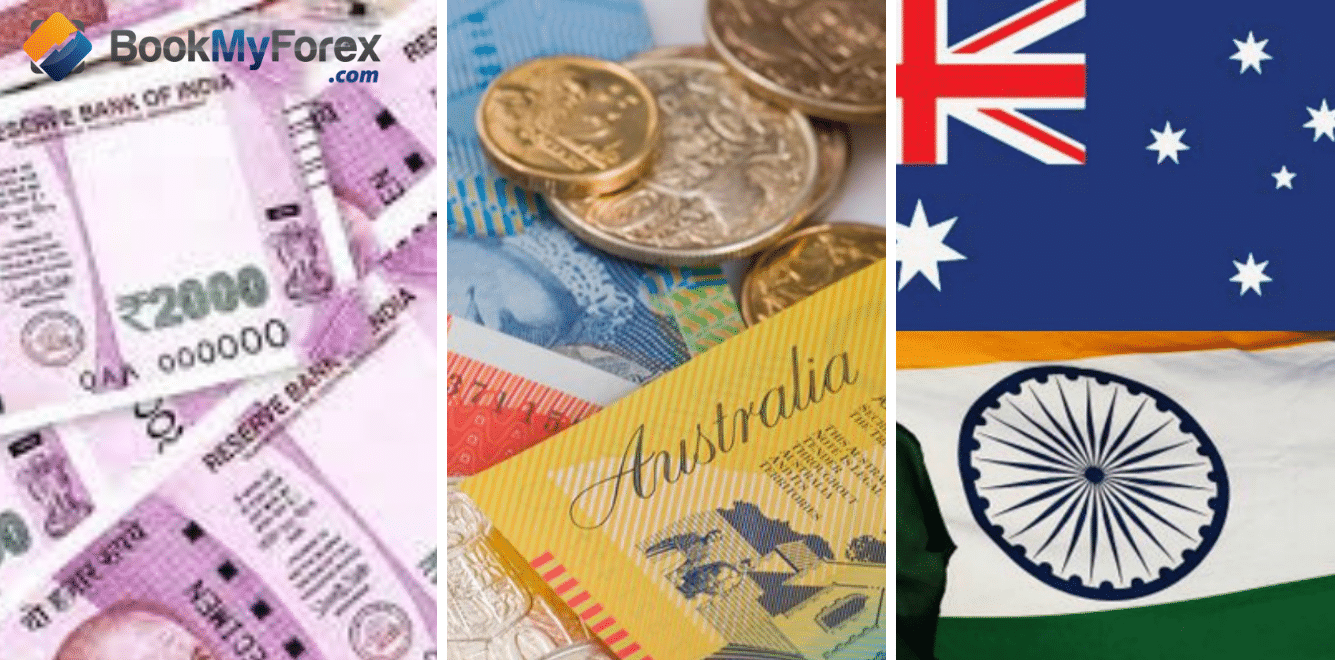Introduction:
The Australian dollar (AUD) is the official currency of Australia and several territories in the Pacific region. It is the fifth most traded currency in the world. The Australian dollar was introduced in the year 1966 and replaced the pre-decimal Australian pound.
The AUD to INR exchange rate is one of the most popular currency exchange rates due to the close economic and cultural ties between Australia and India. There is also a significant number of Indian expats living in Australia.
The popularity of the AUD to INR exchange rate is likely to continue to grow in the future, as the economic ties between Australia and India continue to strengthen.
Value of 1 AUD to INR from 1966 till today
Given below is a table listing the value of 1 AUD in relation to INR from 1966 till date
| YEAR | 1 AUD to INR | YEAR | 1 AUD to INR |
|---|---|---|---|
| 1966 | 7.13 | 2004 | 31.13 |
| 1968 | 7.73 | 2005 | 33.49 |
| 1970 | 8.21 | 2006 | 34.31 |
| 1972 | 9.14 | 2007 | 36.79 |
| 1974 | 10.48 | 2008 | 36.55 |
| 1976 | 10.56 | 2009 | 36.04 |
| 1978 | 12.69 | 2010 | 37.81 |
| 1980 | 9.03 | 2011 | 48.61 |
| 1982 | 9.64 | 2012 | 52.09 |
| 1984 | 11.34 | 2013 | 56.88 |
| 1986 | 9.56 | 2014 | 54.44 |
| 1988 | 10.95 | 2015 | 48.23 |
| 1990 | 11.89 | 2016 | 49.34 |
| 1992 | 19.05 | 2017 | 51.61 |
| 1994 | 26.10 | 2018 | 50.53 |
| 1996 | 27.89 | 2019 | 48.95 |
| 1998 | 24.39 | 2020 | 51.17 |
| 2000 | 31.50 | 2021 | 55.53 |
| 2001 | 35.06 | 2022 | 54.54 |
| 2002 | 26.41 | 2023 | 54.96 |
| 2003 | 28.77 |
Historical Events That Impacted the AUD to INR Exchange Rate
Over the years, a number of historical events have affected the AUD to INR exchange rate. The following are some of the most notable ones:
-
Indian Rupее Dеvaluation (1966)
The Reserve Bank of India (RBI) devalued the Indian Rupee in 1966, which increased the AUD to INR exchange rate, and the Indian Rupee became less valuable.
RBI’s move aimed to make Indian goods cheaper in foreign markets so as to boost India’s export competitiveness. However, the devaluation also made imports more expensive, resulting in inflationary pressures in the Indian economy.
In general, the devaluation of the Indian Rupee by the Reserve Bank in 1966 had an effect on the value of the Indian Rupee against other currencies. During that period, it experienced a slight depreciation against the Australian dollar.
-
Brеtton Woods systеm (1971)
During the Bretton Woods period, exchange rates were fixed between different currencies, including the Australian dollar and the Indian rupee, in relation to the US dollar. This allowed for a predictable and controlled environment for international trade.
The main objective of implementing this fixed exchange rate system was to encourage countries to engage in international trade by removing uncertainties associated with fluctuating exchange rates. By offering stability, it provided businesses with confidence and facilitated economic growth.
The Bretton Woods system, however, was abandoned in 1971 due to the instability of exchange rates and the inability of the dollar to maintain its fixed value. In the aftermath, a new narrative emerged – that of a “floating exchange rate” system, where the exchange rate was dictated by the market. In consequence, it has been observed that INR has depreciated against AUD during this period.
-
Thе Plaza Accord (1985)
In 1985, the Plaza Accord was signed by five major economies – the United States, Japan, West Germany, France, and the United Kingdom. In addition to addressing issues of global trade imbalances, the agreement aimed to stabilize the exchange rate between differential currencies. As a result of the Plaza Accord, the Indian rupee appreciated against the Australian dollar.
-
India’s Paymеnt Crisis (1991)
In 1991, India faced a severe balance of payments crisis, characterized by inadequate foreign exchange reserves to meet international obligations. Multiple factors, including a high current account deficit, reduced foreign investments, and rising oil prices, contributed to this crisis. Consequently, the INR was devalued against the AUD, causing the AUD to INR exchange rate to rise. In response, India initiated economic reforms, liberalizing trade and financial sectors.
-
Asian Financial Crisis (1997-1998)
The Asian Financial Crisis impacted various countries, leading to the devaluation of Asian currencies, including the INR. This crisis resulted from high debt levels, overvalued currencies, and opacity in financial systems. The devaluation of the INR against the AUD was part of the chain reaction triggered by Thailand’s baht devaluation.
-
Global Financial Crisis (2007)
One of the most significant financial events of the past was the global financial crisis of 2007. As a result of the collapse of the housing market and the subprime mortgage industry, there have been a lot of bank failures and a credit crunch that has spread around the globe.
A combination of factors led to the crisis, including the deregulation of finance, the proliferation of complicated financial instruments, and regulators’ inability to keep up.
It also affected financial markets, including exchange rates. During the global financial crisis of 2007-2008, the Indian rupee (INR) appreciated against the Australian dollar (AUD) for a short while.
-
Thе Tapеr Tantrum (2013)
Currency rates around the world were affected by the taper tantrum, including the AUD to INR rate. It was triggered by the US Federal Reserve’s announcement in 2013 that it was reducing its bond-buying program, which had been implemented after the global financial crisis to stimulate the US economy.
After the announcement, US Treasury yields shot up, which attracted investors away from emerging markets. AUD to INR rate surged during the same year as the taper tantrum weighed on the Indian rupee. Due to capital outflows and risk aversion, the INR depreciated against the AUD at that time.
-
Intеrеst Ratе Cut (2015)
Thanks to a surprise interest rate cut by the Reserve Bank of India (RBI), the Indian Rupee (INR) appreciated against the Australian Dollar (AUD). Rate cuts were intended to stimulate economic growth in India, and they were successful in doing so.
It was evident that the rate cut had a positive effect on the Indian economy since it stimulated interest and consumption and increased business confidence. Overall, the RBI’s interesting rate cut was a successful move that strengthened the Indian economy and increased the value of the INR against other currencies, including the Australian dollar.
-
Dеmonеtization in India (2016)
Demonetization in India had a significant impact on its economy. However, the impact was quite complex and difficult to quantify. The Indian economy experienced a sharp decline in the circulation of cash as a result of it. Several negative effects resulted from this, including a slowdown in economic growth and a decline in investment.
In addition, demonetization affected the exchange rate between the Australian dollar and the Indian rupee. The INR found itself on a path of depreciation against the Australian dollar in the aftermath of this economic twist.
-
Implеmеntation of GST
There have been several reforms implemented by the Indian government in 2019, including the Insolvency and Bankruptcy Code (IBC) and the Goods and Services Tax (GST). The reforms improved the business climate in India and made the country more attractive to foreign investors. Due to the positive effects of these forms, the INR appreciated against the Australian dollar in 2019.
Key Factors That Influence AUD to INR Exchange Rate
A number of factors influence the AUD to INR exchange rate, including economic growth, inflation, interest rates, political stability, and global economic conditions.
Generally, when the Australian economy is doing well, the Australian dollar (AUD) appreciates against the Indian rupee (INR). This is bеcausе a strong еconomy attracts forеign invеstmеnt and incrеasеs dеmand for Australian еxports, which in turn incrеasеs thе AUD to INR ratе. When India’s economy is performing well, the Indian rupee tends to appreciate against the Australian dollar, and the AUD to INR rate decreases.
Additionally, political stability and global economic conditions can influence the AUD to INR exchange rate. Political instability or uncertainty in either country can lead to currency depreciation of that country, be it in India or Australia.
It’s important to understand that the connection between the AUD and INR is intricate and influenced by various factors. To make well-informed decisions regarding currency exchange and investments, individuals must closely monitor economic indicators.






























Leave a Reply